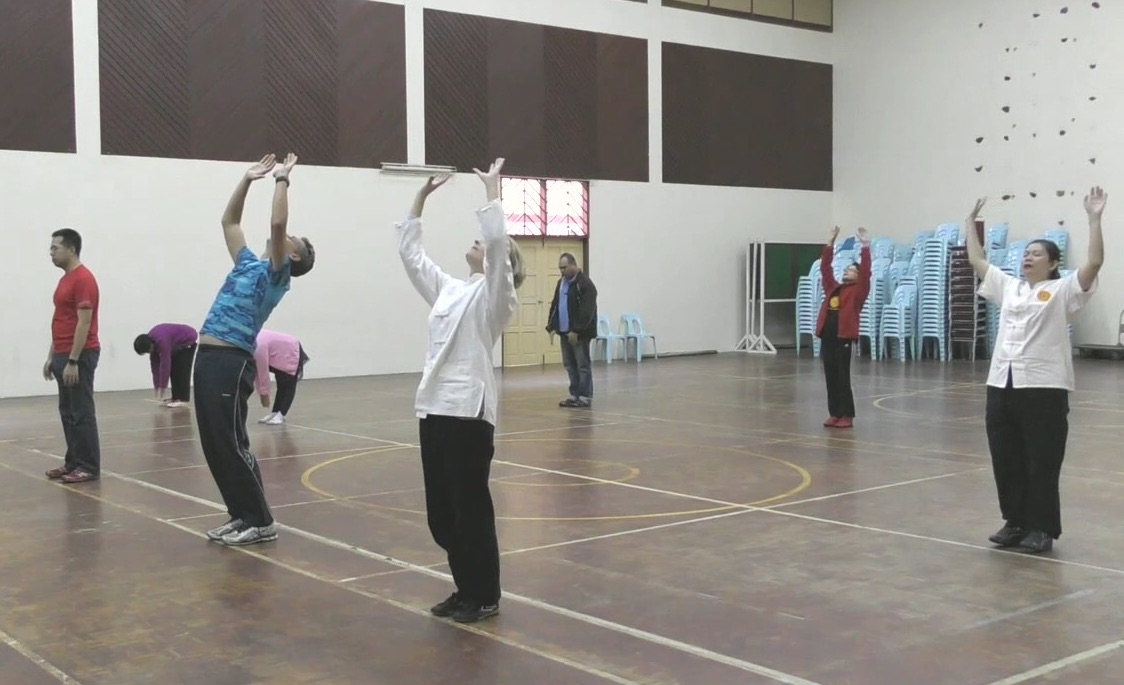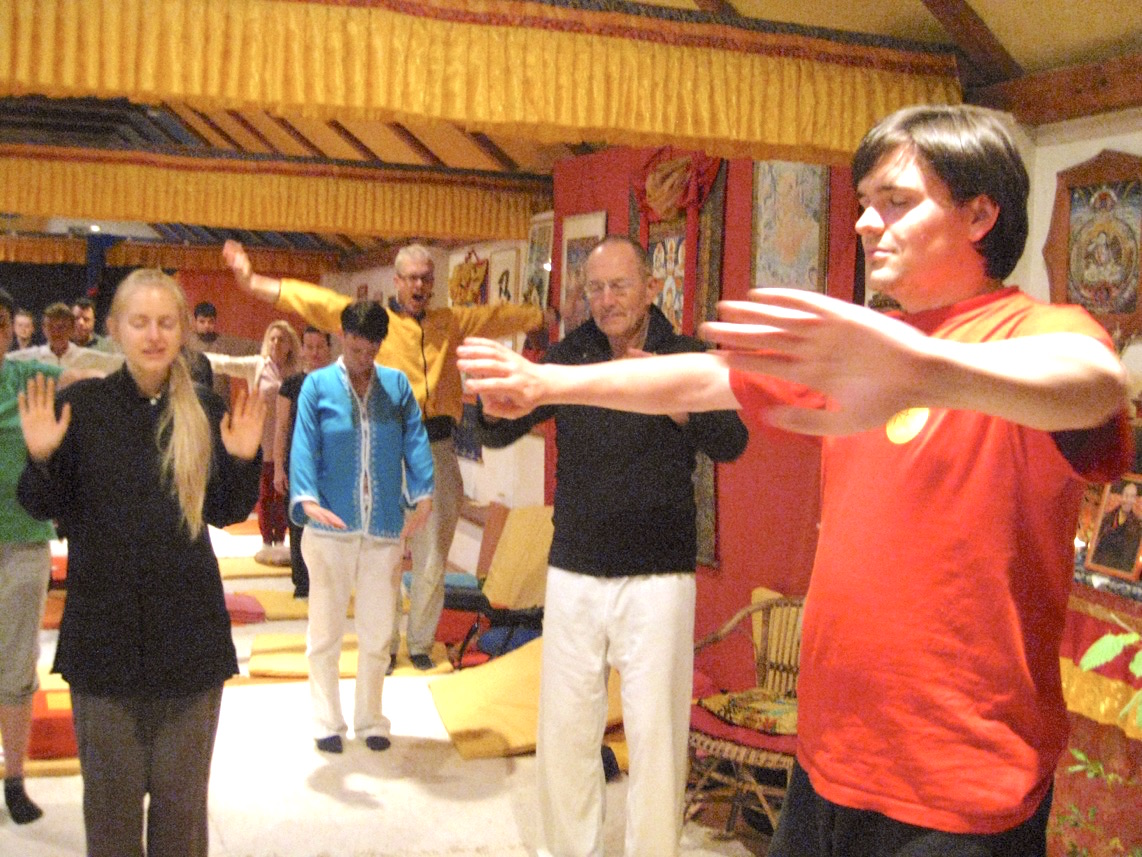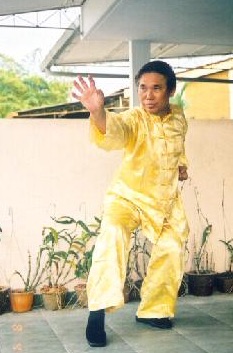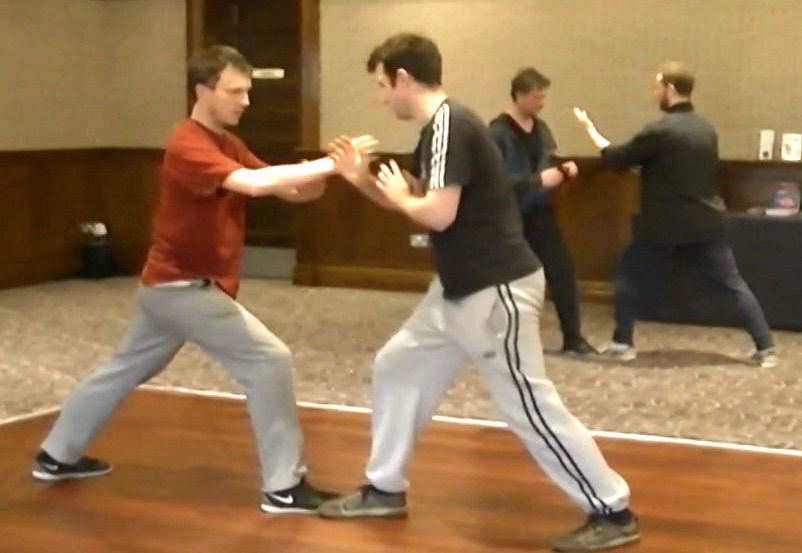SELECTION OF QUESTIONS AND ANSWERS
DECEMBER 2018 PART 2

"Carrying the Moon" during an Intensive Chi Kung Course
Question 1
In an Intensive Chi Kung Course, you teach the same chi kung exercises to different people. Yet, when they return home to practice on their own, they overcome different types of diseases. How is it possible that the same chi kung exercises overcome different types of diseases?
— Michael, United States of America
Answer
Thank you for this interesting question.
Using the same chi kung exercises to overcome a variaty of illness is not sensible in the Western medical paradigm, but in the Chinese medical paradigm it is reasonable and scientific.
From the traditional Chinese medical philosophy, the philosophy that has maintained the health of the biggest population of the world for the longest period of history, there is only one cause of diseases, and it is energy blockage. It there is no blockage, i.e. if chi, or vital energy, flows harmoniously, there will be no illness. Good health is a natural birth-right.
I have used this principle to help countless people to overcome their illness. When different people with different diseases come to see me for healing, I do not see them as suffering from asthma, diabetes, heart problems, rheumatism, depression, anxiety, viral infextion or any disease described variously by Western medicine, I see them as suffering from energy blockage.
I teach them to generate an energy flow. When they return home from my chi kung courses, they continue to practice generating energy flow. When the energy flow clears their blockage, they recover from their illness.
The same reality occurs in Western medicine, or any medicine too, though those familiar with Western medicine may not see it in the same way. If all the systems, organs, issues, glans and cells work the way they are meant to work, no illness will occur. Chinese medical philosophy describes this concept as harmonious energy flow.
Question 2
You also mention that those who wish to overcome their illness, should focus on the first day of your three-day course. You explain that what we learn on the first day is the most basic. Isn't it important that those who wish to overcome illness should focus on advanced exercises?
Answer
Those who wish to overcome their illness, should focus on the basic, which is generating energy flow. This is what I teach on the first day of my three-day Intensive Chi Kung Course.
On the second day, I teach developing internal force and attaining mental clarity, which contribute to peak performance. On the third day, I focus on spiritual cultivation at the highest level, i.e. expanding into the Cosmos.
The three-day Intensive Chi Kung Course is divided into three levels, namely for health, for peak performance, and for spiritual cultivation. The amount of energy needed for their attainment increases accordingly. In other words, least energy is required for health, more energy for peak performance , and the most energy for spiritual cultivation at the highest.
Overcoming illness needs even less energy. Teaching a sick person an advanced chi kung exercise, which will produce a lot of energy, is detrimental to him. It is like asking a sick person to lift weights or run a marathon.

One of the exercises in 18 Lohan Hands, "Separating Water"
Question 3
You say that chi kung can overcome any illness, including what you call s0-called incurable diseases, like cancer and heart problems. Can chi kung really overcome cancer and heart problems? Is this is so, a lot of cancer and heart patients would come flocking to your chi kung courses.
Answer
As early as 20 years ago, in 1997 at the 2nd World Qigong Congress in San Francisco, I was awared Qigong Master of the Year. (Chi kung is spelt as "qigong" in Romanized Chinese.) A main reason for the award was my work in helping people overcome so-called incurable diseases, like cancer and heart problems. In fact, the paper I presented at the Congress was Qigong: a Cure for Cancer and Chronic, Degenerative Diseases? A Global Interest.
I have helped countless people overcome so-called incurable diseases, like cancer and heart problems. However, patients suffering from cancer, heart problems and other so-called incurable disease may not flock to my chi kung courses for various reasons.
Honestly, I am not keen in helping people overcome so-called incurable diseases. I take it as a duty. I prefer teaching chi kung and kungfu to healthy people.
The second reason is that there are legal rules forbidding healers other than qualified Western-trained doctors to treat paients, though some far-sighted countries are now relaxing such rules.
Thirdly and it is a sensitive issue, much of chi kung practiced today is gentle physical exercise using chi kung techniques, just like much of Taijiquan practiced today is outward, dance-like Taijiquan form, and such chi kung practitioners generally do not realize it. Gentle physical exercise cannot overcome any illness.
Fourthly, most people do not know that genuine chi kung can overcome any illness. Even those who use chi kung techniques to perform gentle physical exercise do not believe that genuine chi kung can overcome so-called incurable diseases.
Question 4
How are kungfu sets related to Eighteen Lohan Hands and Sinew Metamorphosis?
— Douglas, Spain
Answer
Most people, including kungfu practitioners, may not realize that their kungfu sets are related to Eighteen Lohan Hands and Sinew Metamorphosis. They may not see any Eighteen Lohan Hands techniques or Sinew Metamorphosis techniques in their kungfu sets, such as in Shaolin Tantui, Wing Choon Kungfu, Yang Style Taijiquan, Swimming Dragon Baguazhang or Five Elemental Fist of Xingyiquan.
But historically, Eighteen Lohan Hands evolved into Eighteen Lohan Fist, which was the prototype of Shaolin Kungfu. As all Shaolin derived arts, like Shaolin Tantui, Chaquan, Eagle Claw Kungfu, Praying Mantis Kungfu, Wing Choon Kungfu, Choy-Li-Fatt Kungfu and Hoong Ka Kungfu evolved from Shaolin, these Shaolin derived arts evolved from Eighteen Lohan Fist, which in turn evolved from Eighteen Lohan Hands.
All styles of Taijiquan and Baguazhang also evolved from Shaolin Kungfu. Hence, they are related to Eighteen Lohan Hands, though because of their long history typical Taijiquan and Baguazhang patterns, like "Immortal Waves Sleeves" and "Green Dragon Tests Claw", do not bear semblance to the Eighteen Lohan techniques.
Some patterns like "Big Boss Lifts Bronze Vessel" in Choy-Li-Fatt Kungfu, and "One-Finger Stabilizes Empire" in Hoong Ka Kungfu, can be traced directly to Eighteen Lohan Hands patterns, like "Lifting the Sky" and "Shooting Arrows".
While the Eighteen Lohan Hands evolved into Eighteen Lohan Fist which became the prototype of Shaolin Kungfu, Sinew Metamorphosis provided the source and inspiration for internal force training in many kungfu sets. Again, because of their long history, it may not be easy to trace their relationship.
An excellent example is the Shaolin Iron Wire Set, which is often considered the most powerful set for internal force training. The Shaolin Iron Wire Set derived its source and inspiration from Sinew Metamorphosis.
Another excellent example is the triple-stretch method used in internal force training in many Southern Shaolin sets, like Dragon Strength, Flower Set and Siu Lin Tou of Wing Choon Kungfu. Some arts, like the Thirteen Grand Guards famous in Ngok Ka Kungfu (Yue Jia Kungfu in Mandarine pronounciation) was derived from Sinew Metamorphosis.
Advanced practitioners of Northern Shaolin styles, like Tantui, Eagle Claw and Praying Mantis owed their internal force from practicing Eighteen Lohan Arts, which developed from Eighteen Lohan Hands. Hence, these northern Shaolin styles are related to Eighteen Lohan Hands, though because of their long history, it may not be easy to relate their connection.

Single Tiger Emerges from Cave
Question 5
Why does a senior practitioner who attended a course previously still attend a same course?
— Moste, Switzerland
Answer
It is because he gets a lot of benefits from the course, besides seeing me and his friends.
When there are senior practitioners in a course, junior practitioners will benefit more than if all the course participants were junior practitioners. The extra benefits are obvious, like the seniors can help the juniors by correcting their techniques and giving them advice.
But in the same course, it is the senior practitioners who get the most benefits. This is a special feature of courses in our school, and may not be so in other schools. Why will our senior practitioners get the most benefits? An important reason is that the seniors can focus on skills, whereas the juniors still struggle with techniques.
For example, in learning "Lifting the Sky", junior practitioners will focus on the techniques, like how to lift their hands, and whether their arms are straight. Senior practitioners already know the techniques very well, so they focus on the skills, like how gently should they breathe in and out, and at what level of performance should they choose to operate so as to get the best benefits.
In a kungfu course, for example, in learning to apply "Single Tiger Emerges from Cave" to defend against "Black Tiger Steals Heart", junior practitioners will focus on the techniques, like "leaning" and not "blocking". Senior practitioners already know the techniques, so they can focus on the skills, like at what point of time should they defend against the attack, or at what point of space should they "lean" on the opponents' arm.
Senior practitioners also learn more about the techniques. For example, in "Lifting the Sky" senior practitioners learn that they should push up with the base of their palms and not with their fingers, and that they should pause for a while after dropping their arms. Junior practitioners will be quite satisfied if they can perform the pattern correctly without worrying about details.
It is not that when the senior practitioners first learned "Lifting the Sky" at a time when they were junior, these fine points of techniques were not taught. At that them they just wanted to perform the pattern correctly, without worrying about details.
Similarly, senior practitioners learn more about the philosophy of the art. They would learn, for example, that "Lifting the Sky" not only generate a chi flow, which was their main concern at the time they first learned the pattern, but also it would give them good posture and help them to free their mind from other thoughts.
It was not because these philosophical points were not mentioned when they first learned "Lifting the Sky", but at that time they were more concerned with using the technique of "Lifting the Sky" to have the skill to generate a chi flow. Now that they can use the technique and skill well, they can focus on deeper philosophy, techniques and skills.
Question 6
In Taijiquan Pushing Hand, the right mode, i.e. right hand and right stance, is used. Why is it that in Wing Choon Chi Sau or Sticking Hand, both hands are used?
— Michael, Switzerland
Answer
It is because Wing Choon Kungfu and Taijiquan are different arts and they use different principles. Both Wing Choon Kungfu and Taijiquan are excellent for the small against the big, but the ways these two arts achieve this aim are different.
Wing Choon Kungfu uses economy of movement, and its strikes aim at vital points. Kicks, felling techniques and chin-na, which are disadvantageous for the small against the big, are seldom found in Wing Choon Kungfu. However, if opponents use kicks, felling techniques and chin-na on a Wing Choon exponent, the latter can counter them effectively.
Taijiquan uses circular movements, which minimize the force of bigger opponents. Besides strikes, kicks, felling techniques and chin-na are found in Taijiquan, though many Taijiquan practitioners may not realize it. Kicks, felling techniques and chin-na are used in Taijiquan after Taijquan exponents have employed circular movements to maneuver their opponents into difficult positions.
Because of these different principles, both hands are used in Wing Choon Chi Sau, or Sticking Hands, and usually the right mode, i.e. the right hand and the right stance, is used in Taijiquan Pushing Hands. If a Wing Choon practitioner uses only the right mode, as in Taijiquan Pushing Hands, he denies himself the use of his left hand and left leg which are important in combat using Wing Choon Kungfu. If a Taijiquan practitioner uses both hands, like in Wing Choon Sticking Hands, he wastes time practicing the left mode which he hardly uses in combat.
As an analogy, it is like asking why we use two hands to type, but only one hand to write. It is because typing and writing are different arts with different principles.

Taijiquan Pushing Hands
Question 7
What are the symptoms of over-training?
— Achim, Switzerland
Answer
Being tired, pain and feeling nauseous are the three very common symptoms of over-training.
A practitioner will feel energized when he has practiced chi kung. But if he feels tired instead, it is a symptom of over-training. He feels tired because he has generated too much energy that his physical body cannot bear it. This tiredness is different from having not enough energy. It is Nature's way of telling him to rest.
He should feel fresh after practicing chi kung, but if he feels painful, it shows over-training. The energy he has gathered from his training is too much that it pushes too hard on his thick blockage making him feel painful. If he has practiced less or less intensely, the energy gathered is less and the push is gentle.
He should feel pleasant after chi kung practice, but if he feels nauseous, it shows that too much negative emotion is being pushed out. If he has practiced less or less intensely, the pushing out of negative emotion is gentle and he feels pleasant.
If a person has practiced wrongly, he may also feel tired, painful and nauseous, but the feelings are different. This is due to the limitation of words. Words do not exactly describe what we want to say when there are shades of difference. A good example is the sour taste of an orange. The sour taste can be due to the fact that the orange is good, and it can also be due to the fact that the orange is bad.
Tiredness, pain and nauseousness due to wrong practice are sharp and severe, whereas those due to over-training are less severe and sometimes even pleasant. Tiredness, pain and nauseousness due to wrong training come immediately, whereas those due to over-training come after pleasant feelings.
Question 8
What should we do if we have over-trained?
Answer
In other schools where students practice for about an hour per session, a good way to overcome over-training is to practice less, like half an hour instead of an hour, or alternate day instead of every day.
Reducing the time of training is not feasible in our school because our practice session for chi kung is short, just about 10 minutes. More significantly, our students enjoy their practice. For those who practice kungfu, the earlier recommendation was an hour. They can reduce their practice time to half an hour.
An excellent way for us in Shaolin Wahnam is to reduce the intensity by not entering too deeply into a chi kung state of mind, or not entering too deeply into Zen or Tao. If you take as 100% the depth you enter into a chi kung state of mind, or enter Zen or Tao, in my courses, half that in your daily practice to 50%. Then half the 50% to 25%.
Practicing at 25%, and not at your potential of 100%, is an excellent way to reduce the intensity of practice, which will overcome or prevent over-training. If you find 25% is still too powerful for your daily practice, you can reduce the intensity to 20% or less.
If you practice at 60% or 70%, you may over-train, and have adverse effects instead of benefits. By practicing at 25% or at an level suitable for you, you get the best results. If you find that you still have over-trained when you practice at a lower level of performance, you may adopt negative action. A good method is to purposely intellectualize. When you intellectualize, your result will be less, but it is the best for you.
Another method is to purposely tense your muscles. Again, your result will be less, but it is good for you if you have over-trained. Have a gentle chi flow at the end of the session to clear the harm caused by your purposely tensing your muscles.
If you have any questions, please e-mail them to Grandmaster Wong via his Secretary at stating your name, country and e-mail address.
LINKS
Selected Reading
- Chi Kung: the Art of Developing Energy
- Skills Transmitted by Grandmaster Ho Fatt Nam for Combat and Daily Life
- Taiji Dance and Genuine Taijiquan
- Accepting a Gift with Laughter
- Scenic Architecture
